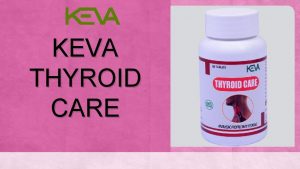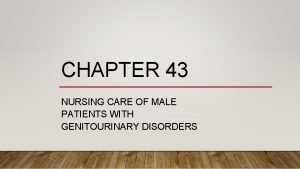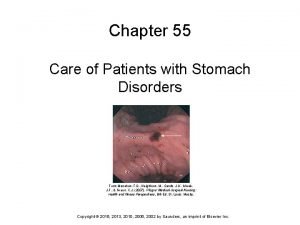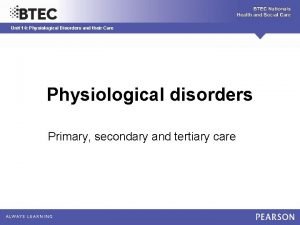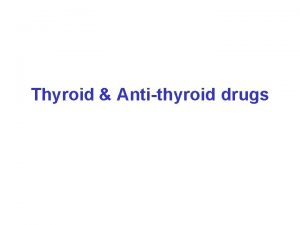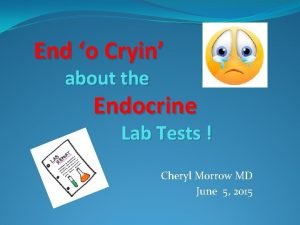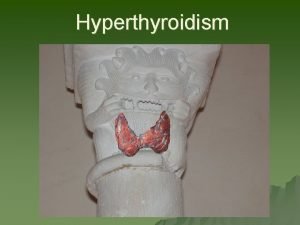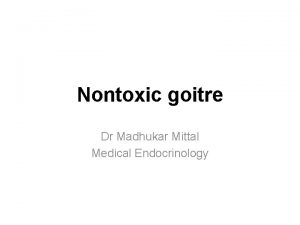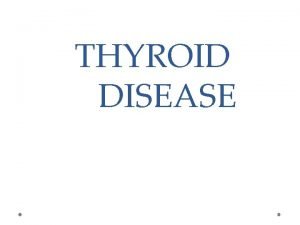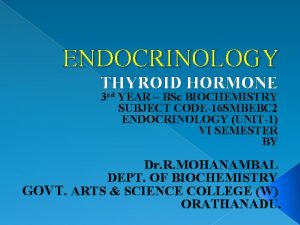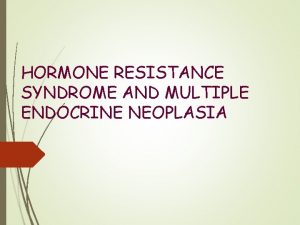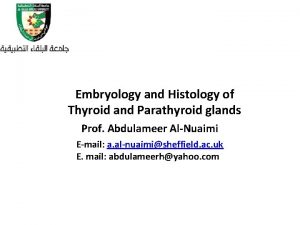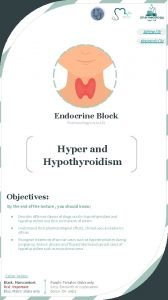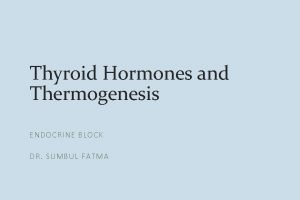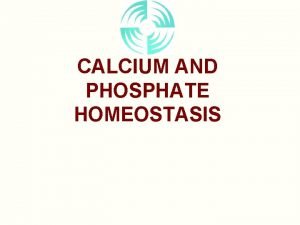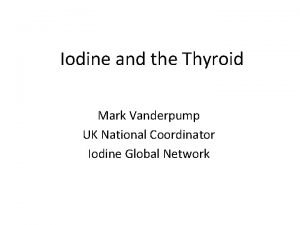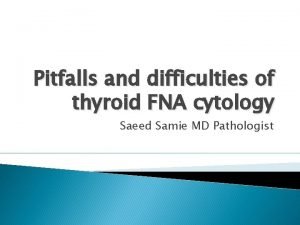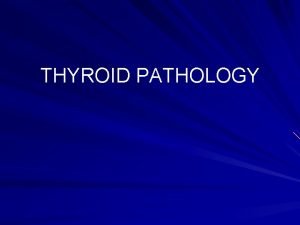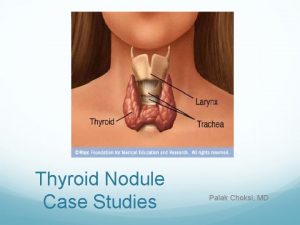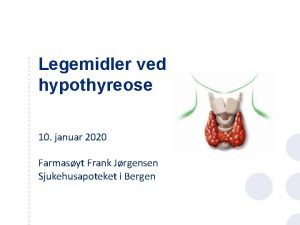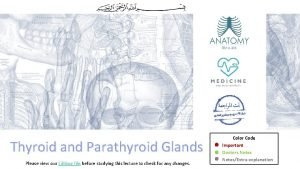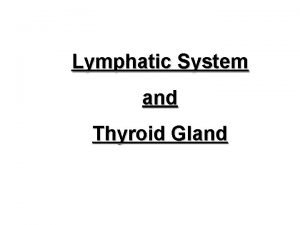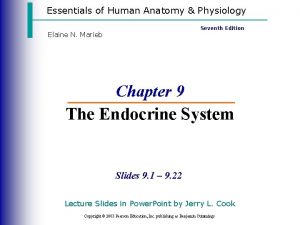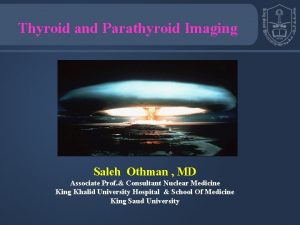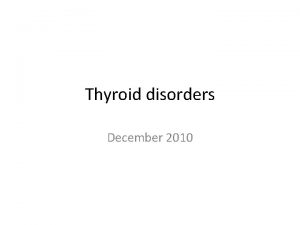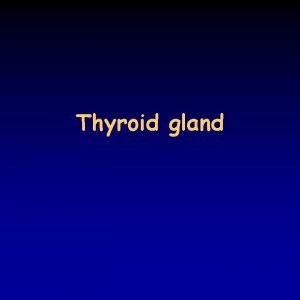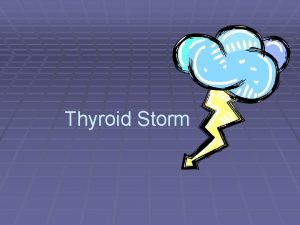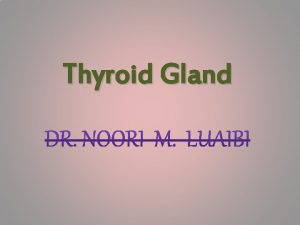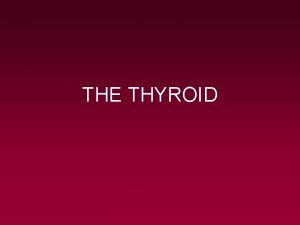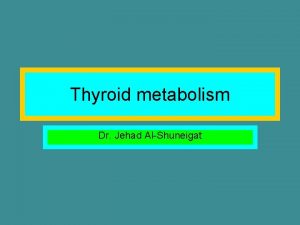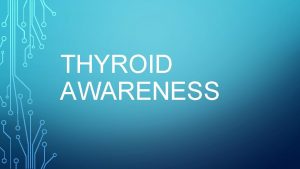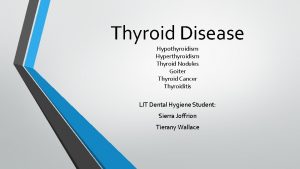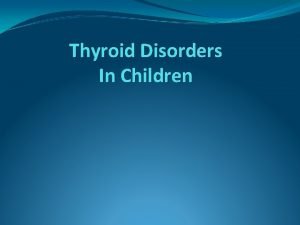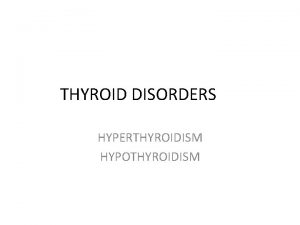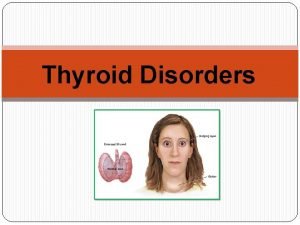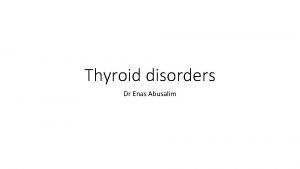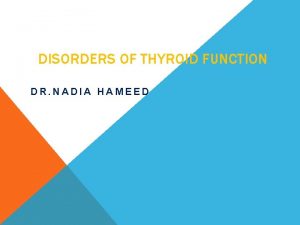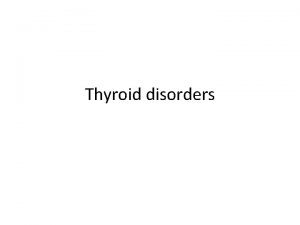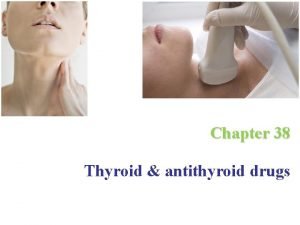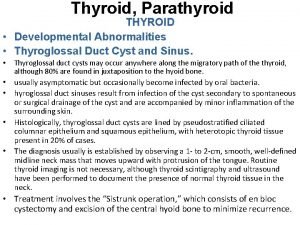Thyroid disorders in everyday care Chris Vreeland RN






































- Slides: 38

Thyroid disorders in everyday care Chris Vreeland, RN, MSN, NP-c Georgia Mountain Endocrinology, PC

Introduction • One in ten Americans have a thyroid disorder • Body’s response to thyroid disorders is fatigue - most common reason to seek healthcare. • Women particularly affected by thyroid imbalance üWeight üFertility üPregnancy üMenopause üOsteoporosis

Thyroid Hormone Action • Activates nuclear receptors which regulate expression of thyroid hormone-responsive genes: ØFetus & neonate: differentiation of target tissues ØChildhood: differentiation/proliferation ØAdolescent: role in action of sex steroids

Thyroid Hormone Action • Gene expression (continued) All ages: • Regulates energy production • Regulates functional /structural proteins • Regulates action of other hormones - glucocorticoids, mineralocorticoids, growth factors, biologic amines (catecholamines)

Negative Feedback Loop • Thyroid hormone inhibits pituitary secretion of TSH • Hypothalamus plays crucial role • TSH very sensitive indication index of action • TSH & thyroid hormones maintained in a certain relationship • Modified by TBG (thyroxine-binding globulin)

Negative Feedback Loop Hyperthyroidism • Elevated serum thyroid level • Decreased TSH Hypothyroidism • Decreased serum thyroid levels • Increased TSH

Serum Levels of Thyroid Hormones • T 3 regulates peripheral action of hormone • T 3 & T 4 both released from gland • Peripheral conversion of T 4 to T 3 occurs in liver and target tissues • In presence of liver damage, T 3 conversion may be low despite good levels of T 4

TBG Metabolism • T 4 transported to tissue by TBG • High serum TBG (liver damage, pregnancy, OCP’s, HRT) lowers serum concentrations of free T 4 which decreases amount of substrate (T 4) that can be converted to T 3 • Indirect measure of TBG abnormality is T 3 uptake

Causes of Thyroid Disorders Hyperthyroidism • Graves’ disease: • Autoimmune • TSH receptor antibodies • Thyroiditis: • Sub-acute • Post-partum • Pituitary tumor - TSH producing

Causes of Thyroid Disorders Hypothyroidism (High TSH, low T 3, T 4) • Hashimoto thyroiditis: • Autoimmune TPO and thyroglobulin antibodies • RAI: radioactive iodine ablation • Surgery • Antithyroid drugs • Goitrogens: lithium, amiodarone

Normal Hormone Levels • TSH: 0. 4 -5. 5 MIU/L • Total T 3: 60 -181 NG/DL • Total T 4: 4. 5 -12. 5 MCG/DL • T 3 Uptake: 22 -35%

Hypothyroidism Symptoms ü Fatigue ü Weight gain ü Cold feeling ü Dry hair, nails, skin ü Hair loss ü Heavier or longer menses ü Constipation ü Peripheral edema ü Periorbital edema ü Bradycardia ü Hypotension ü Infertility

Hypothyroidism • Treatment: • Hormone replacement (L-T 4) üAbsorbed from small intestine ü 6 -day half-life • Daily dosing: 0. 025 -. 300 mgs • Branded preparations preferred to generic üSynthroid üLevoxyl üTirosint

Hypothyroidism • Treatment üInitial dose: ü 1. 7 mcg per kg üPregnant: may need 1. 8 mcg per kg üElderly: usually start at lower doses, esp. with angina or CAD • Monitoring ü 6 -8 weeks after any dose change üAnnually once stable üEach trimester in pregnancy

Hypothyroidism • Myxedema Coma üEnd stage of uncompensated hypothyroidism üPresents most often in elderly and women in winter months üPresent in respiratory failure, hypotension, bradyarrythmia, along with serious precipitating illness üTreatment is T 4 IV @ 1/10 th dose of oral üICU admit for multi-system failure

Hypothyroidism Pearls üMost patients reports feeling best with TSH between 1 -2 üIf TSH normal, but patient still not feeling good, think low T 3; may need Cytomel (oral T 3) üDepression very common üInadequate treatment can contribute to infertility üLook for recent onset of symptom with family history of thyroid disease

Hyperthyroidism Symptoms üAnxiety üPalpitations üUnintended weight loss üDecreased or absent menses üOily skin üFine, silky, oily-appearing hair üHeat intolerance üExopthalmos (not all cases) üTachycardia

Hyperthyroidism Treatment • Anti-thyroid drugs ü Methimazole Inhibits thyroid hormone synthesis in the thyroid gland ü PTU Inhibits thyroid hormone synthesis in the thyroid gland & inhibits peripheral conversion of T 4 to T 3

Hyperthyroidism Dosing: • Tapazole: 10 mg BID or TID • PTU: only 50 mg tablets available Usual starting dose: 2 tabs TID; may double dose if necessary • Both very effective at lowering thyroid hormone levels • TSH will stay suppressed several month

Hyperthyroidism Dosing: üMonitor every 4 -6 weeks üWhen TSH rises, may need to add T 4 (thyroid hormone) üWant to leave on ATD’s long enough to allow TSH receptor antibodies to decrease & induce remission; usually 12 -18 months üPlan to withdraw med at 12 -18 months to evaluate remission status

Hyperthyroidism Side effects of anti-thyroid drugs: • Leucocytopenia • Agranulocytosis-most serious • Pernicious anemia • Thrombocytopenia • Hepatic dysfunction • Allergy (discoid rashes) Evaluate with CMP, CBC, & thyroid hormone levels every 4 -6 months

Hyperthyroidism Radioactive Iodine Ablation • Administration of I 131 iodine by mouth • Used after TFT’s normal or if unable to control hyperthyroidism with drugs • Usually destroys gland over 3 -6 months

Hyperthyroidism Radioactive Iodine Ablation • Induces permanent hypothyroidism • May cause post-treatment thyroid storm (rare) • May cause aggravation of Graves’ eye disease • Pregnancy should be prevented within 6 months after treatment

Hyperthyroidism Surgery • When disease state or gland size can’t be controlled with drugs • When gland causing obstructive signs üDifficulty breathing either supine or upright -Evaluated by PA & LAT CXR üDifficulty swallowing food -Evaluated by barium swallow

Hyperthyroidism • Thyroid Storm • Most often with Graves’ disease • Levels same as with Graves’ • Cardinal signs: Temperature 102 to 1050 Profuse sweating Marked tachycardia (120 -140 pulse rate or higher) Atrial fibrillation • Usually induced by concurrent infection or surgery on hyperactive gland

Hyperthyroidism Thyroid storm • Treatment üPTU orally or by NG tube üTapazole not favored because it does not inhibit peripheral conversion of T 4 to T 3 üBeta blockade, PO or IV üSupportive therapy for fever, dehydration üPerhaps iodine solution or corticosteroids

Hyperthyroidism Graves’ Eye Disease: • Caused by antibody effect on orbital tissue • Symptoms include: üEdema üInflammation üHypertrophy of extra ocular muscles & orbital fat • Exopthalmos upper & lower lid retraction, strabismus, herniated orbital fat

Hyperthyroidism Graves’ Eye Disease: • Should be stabilized for 6 months prior to any other treatment modality • Exception is optic neuropathy caused by strangulation of optic nerve • Extent of protrusion measured by increase in distance between lateral orbital rim and anterior aspect of eye

Thyroid Nodules • May be a single nodule or larger of multiple nodules • 95% benign • More common in women • More likely malignant in men • Increase in size while on T 4 therapy worrisome for malignancy

Thyroid Nodules • Note size, consistency and mobility on physical exam • Evaluate for tracheal deviation or esophageal obstruction • Usually TSH suppressed, T 3 and T 4 levels normal • Antibodies may be present, but more likely they are not • Ultrasound best way to diagnose

Thyroid Nodules Treatment • Multinodular gland without dominant nodule: T 4 to shrink if TSH not suppressed • Single nodule 1 cm or greater: fine needle aspiration biopsy • Enlarging nodule despite “good” dose of T 4 or indeterminate or malignant result from FNA indicates need for surgery

Thyroiditis • Most common cause: chronic autoimmune thyroiditis or postpartum thyroiditis • Next is sub acute thyroiditis • More rare: acute suppurative thyroiditis

Thyroiditis Post-partum thyroiditis • May occur anytime in the first year, but most common in first 3 months • Usually have hyperthyroid symptoms first, followed by hypothyroid findings • Gland usually enlarged • Will not have other markers for inflammation: fever, tenderness, high sed rate

Thyroiditis Post-partum thyroiditis • Usually spontaneously resolve • May need temporary medication support for symptoms üBeta blockers for tachycardia üTranquilizers for anxiety üT 4 for hypothyroidism • Can progress to permanent hypothyroidism

Thyroiditis Sub acute • Usually follows viral illness • Gland is swollen, tender • Sed rate elevated >50 mm/hour • May have fever, even fairly mild • Leucocytosis • Follows usual pattern of transient hyperthyroidism, then hypothyroidism, then euthyroid

Thyroiditis Sub acute • Treatment: üSymptomatic üNSAIDS for pain, fever üPrednisone for severe pain unrelieved by above üBeta blockers for hyper phase üThyroid replacement for hypo phase üResolve spontaneously

Questions?

Thank you!
 Keva eye drops
Keva eye drops Levels of nursing care primary secondary tertiary
Levels of nursing care primary secondary tertiary Nursing care of male patients with genitourinary disorders
Nursing care of male patients with genitourinary disorders Pneumatic reduction of intussusception
Pneumatic reduction of intussusception Health and social care unit 14 coursework
Health and social care unit 14 coursework Chapter 55 care of patients with stomach disorders
Chapter 55 care of patients with stomach disorders Physiological disorders and their care
Physiological disorders and their care Armour thyroid dosage chart
Armour thyroid dosage chart Subacute thyroiditis
Subacute thyroiditis Secondary hypothyroidism
Secondary hypothyroidism Multinodular goiter pathophysiology
Multinodular goiter pathophysiology Dr madhukar mittal
Dr madhukar mittal Thyroid
Thyroid Biochemistry of hormones
Biochemistry of hormones Ata thyroid
Ata thyroid Thyroid resistance syndrome
Thyroid resistance syndrome Thyroid and parathyroid glands histology
Thyroid and parathyroid glands histology Sella turcica
Sella turcica Proptosis
Proptosis Thyroid hormone synthesis mnemonic
Thyroid hormone synthesis mnemonic Thyroid hormone secretion
Thyroid hormone secretion Four oval masses on posterior thyroid gland
Four oval masses on posterior thyroid gland Dr. hamidreza zakeri
Dr. hamidreza zakeri Surfaces of thyroid gland
Surfaces of thyroid gland Thyroid liver
Thyroid liver Bethesda thyroid cytology
Bethesda thyroid cytology Thyroid pathology
Thyroid pathology Thyroid stimulating hormone
Thyroid stimulating hormone Rima vestibuli function
Rima vestibuli function American thyroid association guidelines pregnancy 2017
American thyroid association guidelines pregnancy 2017 Palak choksi
Palak choksi Thybon bivirkninger
Thybon bivirkninger Thyroid ultrasonography
Thyroid ultrasonography Isthmus size
Isthmus size Thyroid class 11
Thyroid class 11 Lymph vessel
Lymph vessel Thyroid anatomy
Thyroid anatomy Acog thyroid pregnancy
Acog thyroid pregnancy Parathyroid gland location
Parathyroid gland location
